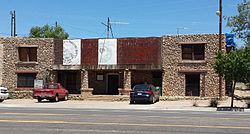Peach Springs Trading Post
Appearance
Peach Springs Trading Post | |
 | |
| Location | 863 W. AZ 66, Peach Springs, Arizona |
|---|---|
| Coordinates | 35°31′44″N 113°25′37″W / 35.52889°N 113.42694°W |
| Area | less than one acre |
| Built | 1928 |
| Built by | Davis, Cecil |
| Architectural style | Pueblo |
| NRHP reference No. | 03001196[1] |
| Added to NRHP | November 21, 2003 |
The Peach Springs Trading Post, at 863 W AZ 66 in Peach Springs, Arizona, is a historic building built in 1928. It was built by Cecil Davis and includes Pueblo Revival architecture. It has served as a post office and a general store and also as a dwelling. It was listed on the National Register of Historic Places in 2003.[1]
In 2003, it was owned by the Hualapai Indian Nation.[2]
A 1936 postcard image depicts young men on horseback in front of the post, with a swastika in the signage of the post in the background.[3]
References
- ^ a b "National Register Information System". National Register of Historic Places. National Park Service. July 9, 2010.
- ^ Pat Haigh Stein (August 2003). "National Register of Historic Places Inventory/Nomination: Peach Springs Trading Post". National Park Service. and accompanying five photos, including a 1936 postcard image that has a swastika
- ^ Note: the swastika cross, while having general connotations now with Nazism, has been used by various Indian cultures with no such association; it is uncommon to see it used publicly as in the 1936 postcard included in the NRHP nomination, however.
Categories:
- Commercial buildings on the National Register of Historic Places in Arizona
- Traditional Native American dwellings
- Buildings and structures completed in 1928
- Buildings and structures in Mohave County, Arizona
- Pueblo Revival architecture
- National Register of Historic Places in Mohave County, Arizona
- Arizona Registered Historic Place stubs


